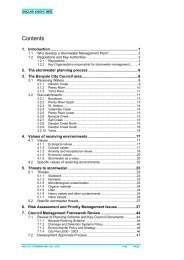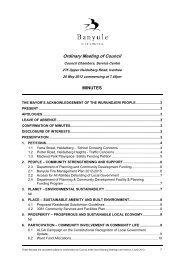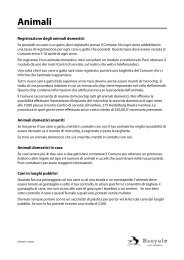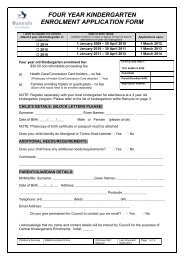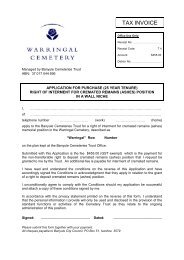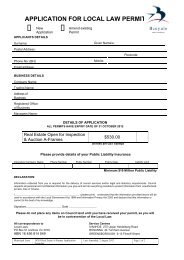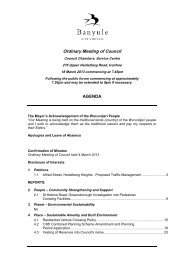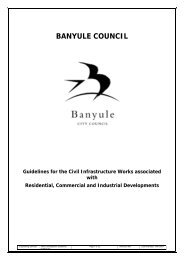Rights of Way - Banyule City Council
Rights of Way - Banyule City Council
Rights of Way - Banyule City Council
You also want an ePaper? Increase the reach of your titles
YUMPU automatically turns print PDFs into web optimized ePapers that Google loves.
2. In certain circumstances, <strong>Council</strong> may have agreed<br />
to be responsible for the repair and maintenance<br />
<strong>of</strong> the right <strong>of</strong> way.<br />
3. Otherwise, maintenance and repair responsibilities<br />
would fall to the owner <strong>of</strong> the right <strong>of</strong> way. Where<br />
the owner is the original owner or subdivider,<br />
<strong>Council</strong> relies on the goodwill <strong>of</strong> its residents to<br />
maintain rights <strong>of</strong> way in order to preserve the<br />
appearance (and security) <strong>of</strong> the area immediately<br />
adjacent to their properties.<br />
Who is responsible for fencing on<br />
rights <strong>of</strong> way?<br />
Under the provisions <strong>of</strong> the Road Management Act<br />
2004, <strong>Council</strong> has no obligation to construct or maintain<br />
fencing on land abutting rights <strong>of</strong> way or other land<br />
defined as a ‘road’ under the provisions <strong>of</strong> the Local<br />
Government Act 1989.<br />
Who is responsible for removing<br />
obstructions and encroachments in<br />
rights <strong>of</strong> way?<br />
Where rights <strong>of</strong> way are obstructed by abandoned<br />
vehicles, substantial hard rubbish or other materials,<br />
you should contact <strong>Council</strong>’s Customer Service Unit on<br />
9490 4222 to arrange for the Local Law Unit to have<br />
the matter investigated.<br />
<strong>Rights</strong> <strong>of</strong> <strong>Way</strong><br />
(roads)<br />
Discontinuance<br />
What is the difference between a<br />
discontinuance and closure <strong>of</strong> a right<br />
<strong>of</strong> way?<br />
The discontinuance <strong>of</strong> a right <strong>of</strong> way (or road) removes<br />
the ‘road’ status from a parcel <strong>of</strong> land so that the land is<br />
no longer available for public use. The closure <strong>of</strong> a ‘road’<br />
temporarily (or permanently) restricts the passage <strong>of</strong><br />
vehicular and/or pedestrian traffic upon a parcel <strong>of</strong> land<br />
whilst retaining the road status <strong>of</strong> the land.
What are rights <strong>of</strong> way?<br />
Generally speaking, rights <strong>of</strong> way are narrow roads providing<br />
access to the rear, and sometimes the side <strong>of</strong> properties. (In<br />
the past, rights <strong>of</strong> way were referred to and used as ‘night<br />
cart’ lanes). A right <strong>of</strong> way may merely be a right to use<br />
land for carriageway or access purposes or it could be a<br />
‘paper road’ i.e. land set aside on a plan <strong>of</strong> subdivision as a<br />
‘road’ but never used or constructed as a ‘road’.<br />
When can <strong>Council</strong> discontinue rights<br />
<strong>of</strong> way?<br />
The Local Government Act 1989 provides <strong>Council</strong> with<br />
the power to discontinue rights <strong>of</strong> way and roads when<br />
<strong>Council</strong> forms the view that the right <strong>of</strong> way or road is ‘no<br />
longer reasonably required for public use’.<br />
In general, this means that <strong>Council</strong> must be satisfied that<br />
adjoining property owners do not reasonably require<br />
access to their properties via the right <strong>of</strong> way or road.<br />
A request to <strong>Council</strong> for the discontinuance <strong>of</strong> a right <strong>of</strong><br />
way (or roads) is assessed in accordance with the ‘<strong>Rights</strong> <strong>of</strong><br />
<strong>Way</strong> (Road) Discontinuance Policy’ adopted by <strong>Council</strong> on<br />
21 February 2000.<br />
<strong>Council</strong> does not encourage the discontinuance <strong>of</strong> a<br />
right <strong>of</strong> way that is constructed on or contains an open<br />
drain. However, such rights <strong>of</strong> way can be considered<br />
for discontinuance in certain circumstances i.e. when<br />
all abutting owners consent to the<br />
proposed discontinuance and agree<br />
to meet the cost <strong>of</strong> removing<br />
the existing paving and/or<br />
installing an underground<br />
drainage system.<br />
What is involved in discontinuing rights<br />
<strong>of</strong> way?<br />
When a written request is received, <strong>Council</strong> <strong>of</strong>ficers<br />
assess the information provided and carry out preliminary<br />
investigations to gauge the suitability <strong>of</strong> the right <strong>of</strong> way for<br />
discontinuance and sale.<br />
Details <strong>of</strong> the proposal are referred to service authorities<br />
for comment and consent to the proposal.<br />
If, following these preliminary investigations, <strong>Council</strong><br />
considers that the proposal for discontinuance and sale is<br />
feasible, the land is allocated and valued in accordance with<br />
<strong>Council</strong> policy.<br />
Before <strong>Council</strong> decides whether or not to discontinue the<br />
right <strong>of</strong> way and sell the land to an abutting owner, the<br />
proposal must be publicly advertised. Submissions are invited<br />
from members <strong>of</strong> the public and must be considered by<br />
<strong>Council</strong> in accordance with the legislative provisions.<br />
If, having considered any submissions, <strong>Council</strong> forms the view<br />
that the right <strong>of</strong> way is ‘no longer reasonably required for public<br />
use’ <strong>Council</strong> may resolve to discontinue the right <strong>of</strong> way and<br />
either sell or retain the land. Notice <strong>of</strong> <strong>Council</strong>’s resolution<br />
is then published in the Victoria Government Gazette to give<br />
effect to the discontinuance. <strong>Council</strong> may then proceed to<br />
<strong>of</strong>fer the land for sale to an abutting owner.<br />
This statutory procedure is <strong>of</strong>ten a lengthy process and may<br />
take up to 12 months to complete.<br />
What information should be supplied<br />
to <strong>Council</strong>?<br />
Requests for discontinuance <strong>of</strong> rights <strong>of</strong> way require a<br />
written application. Requests must be accompanied by:<br />
• A map or plan showing the right <strong>of</strong> way and any<br />
vehicular or pedestrian gates and access points;<br />
• Evidence that the right <strong>of</strong> way is ‘not reasonably<br />
required for public use’. (This can include<br />
photographs and/or statutory declarations by<br />
abutting owners).<br />
• Evidence that abutting property owners and<br />
occupiers affected by the proposed discontinuance<br />
support the proposal;<br />
• A non-refundable application fee <strong>of</strong> $110.00<br />
(inclusive <strong>of</strong> GST).<br />
Who owns rights <strong>of</strong> way?<br />
Land subdivided prior to 1988 left infrastructure assets,<br />
including roads, streets, rights <strong>of</strong> way and reserves, in the<br />
name <strong>of</strong> the original owner or subdivider <strong>of</strong> the land. As<br />
a result, and contrary to popular belief, <strong>Council</strong> is rarely<br />
the registered owner <strong>of</strong> such infrastructure assets, but<br />
merely the custodial manager.<br />
Who is responsible for the<br />
maintenance <strong>of</strong> rights <strong>of</strong> way?<br />
The person responsible for maintaining a right <strong>of</strong> way<br />
(road) will <strong>of</strong>ten depend on the circumstances surrounding<br />
a particular right <strong>of</strong> way. As a general guide:<br />
1. If the right <strong>of</strong> way constitutes a carriageway<br />
easement, the ongoing repair and maintenance <strong>of</strong><br />
the easement is the responsibility <strong>of</strong> the person<br />
who has the benefit <strong>of</strong> the easement.



